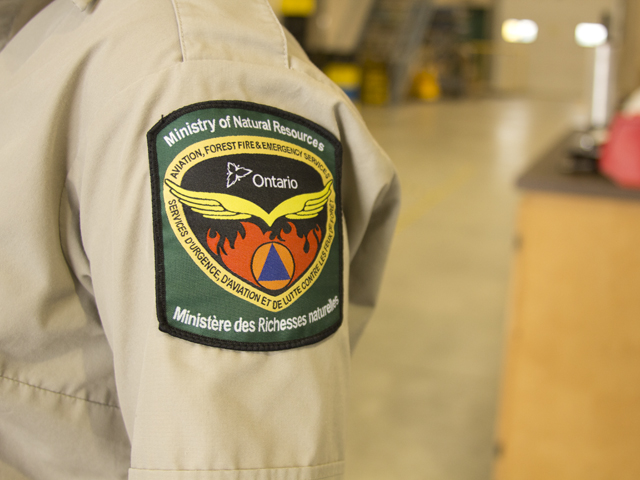After a cozy diner breakfast with Lee at Chummy’s Restaurant in Beardmore in the pouring rain, we packed away the soaking wet trailer and headed up the road to explore the rest of Greenstone.
A recent amalgamation, the Greenstone municipality chops like a Tetris piece for a hundred kilometres or so along highway 11, and consists of the wards of Beardmore, Geraldton, Nakina, and Longlac, as well as the smaller townships and surrounding areas.
We stopped first at the Geraldton Interpretive Centre, and pored over the scale model of Geraldton to get a better perspective of the geography of the area. The Centre itself is built on the site of an old gold mine — one of the ten gold mines in the area — and the Macleod-Cockshutt Headframe #2 is preserved for curiosity and photographs just across the road. The landscaped reclamation of the 200-acre tailing pond is also open for tours.
A scale model of the Bombardier CL-415 water bomber hovers over the entrance hall, and interesting and well-curated displays showcase Geraldton’s history, from the First Nations communities, who greeted the first European visitors, to the early pioneers and the development of the mining industry. Greenstone is famous for its Chromium deposits – the potential new Ring of Fire mine is 300km north of Geraldton.
The town itself is located amidst several smaller waterways about 30km west of Long Lake. The lake, prior to its damming, was a major waterway for paddlers traveling from Lake Superior to James Bay. Much of the fur trade used this route – the Hudson’s Bay Company even opened an outpost in Longlac to prevent their competitor North West from purchasing traders’ goods before they reached the closest HBC outpost at Moose Factory. (The companies united in 1821 to prevent bloody skirmishes between rival employees.)
Just east of Geraldton, Highway 11 passes over a causeway with Lake Kenogamisis stretching out into the distance on both sides, fishing lodges and camps tucked away in the tiny bays. And heading into Longlac, the road curves around the top of Long Lake and the jutting promontory where the old Infant Jesus mission church stands watching over the town.
Looking out over the water, the relative speed of our journey by highway and railway really makes one realize the immense scale and ambition of the old canoe route. We had just driven the several hundred kilometers from Lake Superior, and we traveled the 600km or more of the route to James Bay back in June. All of a sudden thinking outside the pavement, and learning about the importance of Lake Kenogami as a travelway, as well as the history of the Rainy River demonstrated at Kay-Nah-Chi-Wah-Nung, gives one a sense of the vast network of waterways that span this province – indeed the whole eastern half of the continent – and the pivotal role they played in the development of this country.
And this afternoon we really got to see just how vast this part of the country is. We visited the Greenstone Fire Management Headquarters just north of Geraldton, which is responsible for managing forest fires in one seventh of the total area of Ontario. It’s a full service operation: two water bombers – one is in the shop recovering from damage sustained from a recent lightning strike! – and several air attack planes, which scout the fires and report conditions to the bombers. There’s a repair and maintenance area, a warehouse, two monitoring stations, and an operations room. When we visited, the staff were managing 40 forest fires! We even got to hang out in cockpit of the landed Bombardier CL-415 water bomber with its pilot Steve.
On our way back to Geraldton we dropped in to the Recon Air barns just on the other side of the runway. Roy Leuenberger and his crew specialize in the rebuilding and resale of De Havilland DHC-2 Beavers and DHC-3 Otters. The ultimate northern Ontario bushplane, the DHCs were taken off the assembly line in the 1967, and there are only about 400 left – only 466 Otters were ever made; there were 1200 or so Beavers. Some planes, like the Otter operated by White River Air, are found languishing overseas – fusillage lined with chicken wire and housing a coop of hens; wings sliding local laughing children into a nearby water hole – and brought back to Geraldton to be restored for use in the bush.
Heavy rain and general exhaustion aborted our planned mission to Nakina and dinner in the old CNR Station restaurant, and after a little reconnaissance around Geraldton and a dinner of fried chicken and potato “wedgies” – a local tradition – we continued on to Longlac and the comforts of a roadside motel.
Tomorrow – Our hustle down the highway back to Timmins! And lunch with the aliens in Moonbeam…
Photo by Alexandra Sawicki












Very interesting! Hope Alexe has lots of photos of this!